StarDrive is a really great idea—a spacefaring 4x tactics game with real-time combat and lots and lots of options and customizations. Perhaps the game is too ambitious, perhaps some of the bits-and-bobs start to trip over themselves in ways that one would not have foreseen—whatever happened, StarDrive doesn’t quite deliver on its own potential.
That said, I don’t want you to think that StarDrive is not worth your time. It’s an excellent game with a great aesthetic, and the passion of the designers is well-read in the game’s many facets. This passion alone would be good enough reason to experience the game, but luckily that’s not its only redeeming feature.
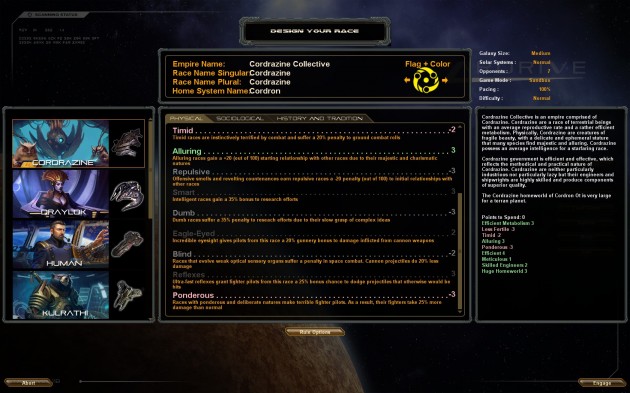
With loads and loads of advantages and disadvantages to choose from, players can really have a faction that works the way they want, while keeping everything balanced.
With a game this complex, it’s hard to know where to start, but the core mechanic that makes this game unlike most 4x games is the real-time aspect, so let’s start there: The game plays much like any other 4x game: the player starts out with a tiny civilization (by the scale of the game world), and must proceed to make choices about where to invest time and resources. What must be researched next? What kind of military or domestic units and buildings should be built? How much should the citizenry be taxed? Unlike other games, however, the decisions here are made on the fly, while the empire is running. It’s possible to pause the game while making a decision, but one does not take ‘turns’ in the traditional sense. This imparts a sense of urgency to the decisions one jumps into,which is great, but it also leads to major oversight pretty easily. For example: The first game I played, I was wasting scientific resources for hundreds of years at one point because I had forgotten to tell my scientists to research anything, and they didn’t bother to remind me. I think that some pop-ups could help with situations like this, but the game is content to allow the player to make these mistakes unhindered.
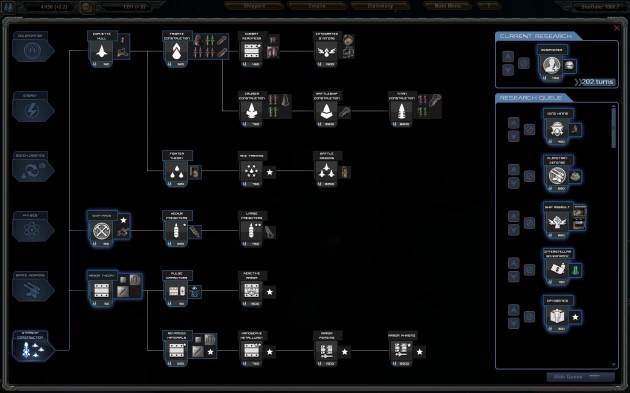
With six scientific categories, each with a couple dozen techs, it certainly wasn’t from lack of choices that my scientists went without work.
The real-timeness also makes the game feel significantly less tactical. One feels that every decision has a time-limit, and that time cannot be taken to look at every angle and make the best decision for one’s empire. As I mentioned, it’s possible to pause the game at any time, but this doesn’t really make up for the hurried nature. I feel like a turn-based option would have made a lot of other rough edges in the game a lot smoother.
The map that the game takes place on is randomized, and full of a wide variety of settlement locations (planets), some more viable than others. The map itself is one of the few elements of the game that actually seems poorly thought-out from a design standpoint. The controls for getting around are counter-intuitive and not customizable. One gets used to them after a while, but even after hours of play, I still occasionally got frustrated that I couldn’t just drag the map around or zoom the way I expected.
Despite this, everything on the map screen, and everywhere else, looks great. Fonts are well chosen, and well-sized. All elements are clear and readable, notifications have easily understood implications, and the leader animations for the diplomacy screen are clever and amusing. In general, the designers understand when to be representative and when to be symbolic with a depth that few designers, even at the top of the genre, really understand. Despite the complicated nature of the game, everything is clean, and it never feels cluttered or overwhelming.
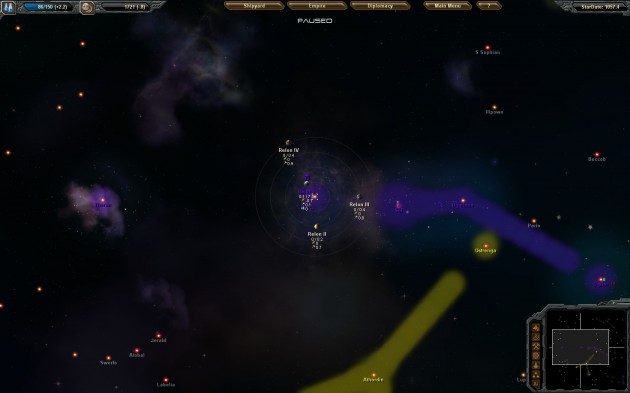
Each star has a system of planets, and each planet has its own properties. Stars can be expanded to show their systems in detail without zooming in. Some, like gas giants, are entirely inhospitable.
Nearly every decision in the game can be automated. Whether this is good or bad will fall to your personal tastes, but avoiding any automation is a viable option. The player can automate their individual settlements by turning on the planet’s ‘governor’, useful when the empire starts to get too big to micromanage, but that’s not the end of it. Players can choose to also automate the exploration of the galaxy and/or the movement of resources around the empire; In both cases, the AI will not just perform the actions, but queue up the building of the necessary ships in settlements which can afford it, and decide priorities for transport and discovery all in the background, allowing the player to literally never worry about those aspects of governance. Exploring is my favorite part of any 4x game, so I made sure to do all that manually, but I found a lot of use in the partial automation of the trade network inside my borders.
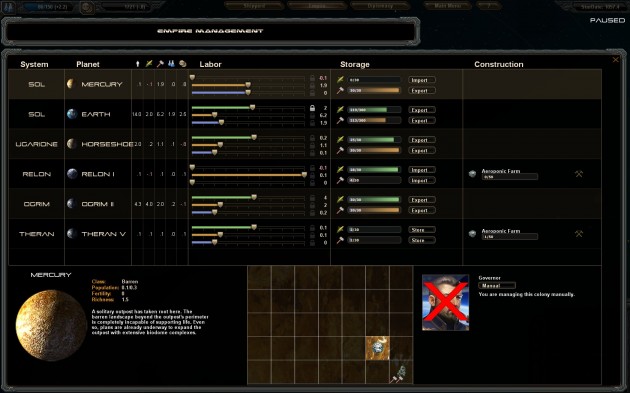
One may also manage their empire from this handy Empire Management interface.
It feels like, with all the many elements to consider, it’s intended that the player is going to automate some of it. The only aspect I would say is a necessity to automate, however, is the building of warp lanes (the ‘roads’ of your empire). These lanes have to be built one segment at a time by a special ship which has to fly out to a designated location and be activated. The process is actually pretty tedious to try to do manually, and the AI can line-up and space out the lane generators perfectly to create nice clean lines with no waste between your worlds. Honestly, I would recommend one doesn’t even try to play with this aspect of governance. Just automate it from the start, and leave it automated, and watch the pretty warp lanes stretch through the empire.
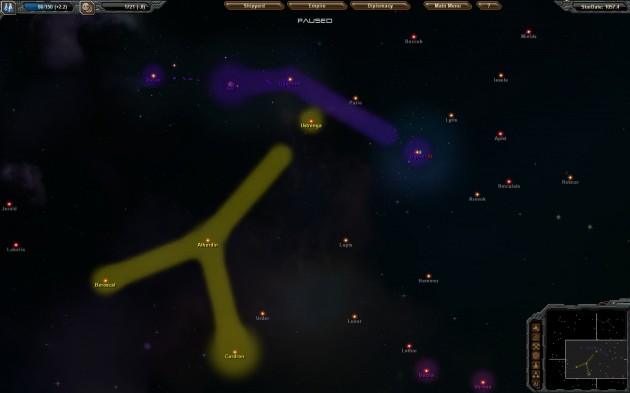
Pretty Warp-lanes.
Players can also automate the building of a fleet of ships, which is a really neat addition. The player can customize a list of ships, in a particular formation, then tell the game to build that fleet. The AI will send build orders to your various colonies in such a way to build the fleet most efficiently in the settlements that can most afford it, then order those ships to all gather, in formation at a central location. All the tedium of army building is taken out of the player’s hands.
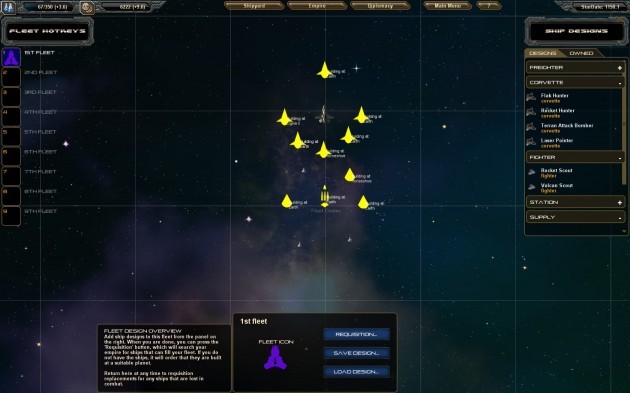
Design a fleet and order it built.
This brings me to the ship designer, which I absolutely adore. By far, this is my favorite feature of StarDrive, and may be the facet of the game which redeems its other flaws. Here’s how it works:
When the player researches various techs, these techs do not unlock new units directly, but instead unlock components. Each component has a function; a size, a power requirement, a construction cost, and a designation as either an internal component or a hull component. Some default ship designs are opened up when enough components are unlocked, but what one really wants to do is get into the ship designer, pick a ship chassis, and load in the components one really needs that ship to have. Any combination of parts in any amounts that fit into the ship is allowed. These designs are saved, and become available to build in your shipyards. It allows a level of military customization that we haven’t seen since Alpha Centauri, and this system is more flexible and modular than that one.
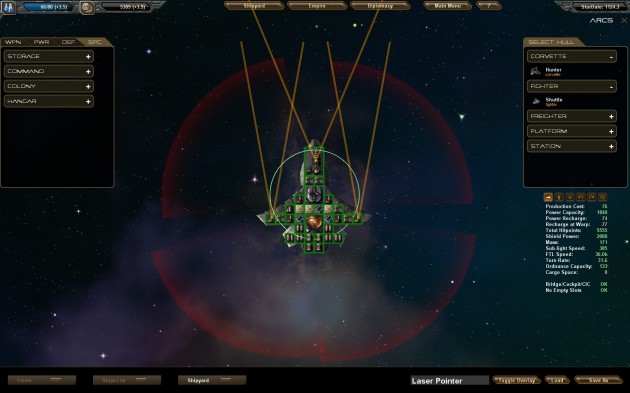
I call this one the Laser Pointer. It’s basically a laser arsenal with engines.
Countering the beauty of the ship designer, however, is the win conditions, which restrict freedom in the worst way. There is really only one way to win: Be the last faction still alive. You have a choice in how to take over other factions, through diplomacy or conquest, but it comes out the same in the end. Even if they are your friends, other factions won’t allow themselves to be subsumed unless you can overpower them, so the answer to everything is to have the best military, and the mid-game can drag a bit after all the settleable worlds are explored and settled, and one is simply waiting for the militaries to clash. The game could really have benefited from some other possible goals, if for no other reason than to give the player something to focus on when not much else is happening.
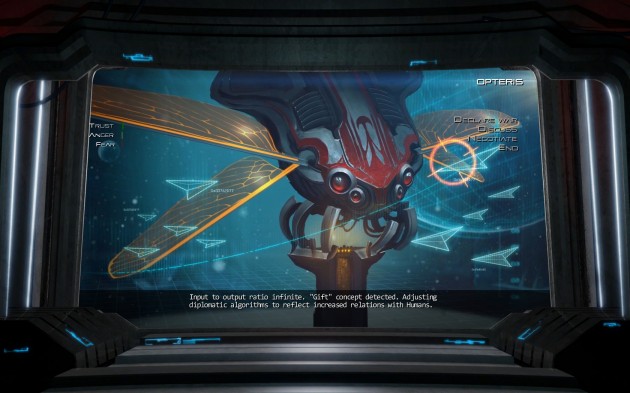
Some factions are easier to placate than others.
A final word of warning: If you give StarDrive a shot—which you should because the unique features of the game and the clearly well-wrought aesthetics do ultimately make up for the lack of win conditions and clunky map controls—watch your empire’s funds closely. Never, NEVER run out of cash. As soon as your citizens realize that you are out of money, they begin to revolt, which just costs more money, and your empire will fold like an origami Shar Pei.
StarDrive is available for Windows on Steam, and is currently priced at $29.99.






 Articles RSS
Articles RSS